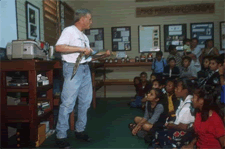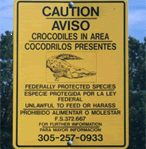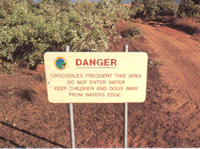Scientific Approach for Developing an Education Plan for Endangered Species Recovery: The American Crocodile in Belize and Florida
Authors
Jocie A. Graham, Frank J. Mazzotti, Janas E. Sinclair, and Jodie Smithem
Background
The American Crocodile (Crocodylus acutus) occupies the northernmost limit of its range in South Florida and is also distributed along the coast of Belize, C.A. C. acutus is listed as endangered in the U.S. and globally vulnerable according to the 1996 IUCN Red List. Both the Florida and Belizean human populations are on the rise, leading to encroachment on prime crocodile habitat. This has led to interaction between humans and crocodiles. In Belize, tourism development is threatening the stronghold for the C. acutus in offshore islands and bays. In Florida, crocodiles are reoccurring in areas that were once natural, but now inhabited by humans. When these circumstances occur, crocodiles can pose a risk to humans and pets. In Belize, fatal and nonfatal attacks have taken place, and in Florida, calls to state agencies about nuisance crocodiles are increasing. Fear and lack of public education about crocodiles have resulted in crocodile mortality and relocation, safety concerns, and an unsatisfied public. Exaggerated or insufficient perceptions of risk from crocodiles may explain these problems in human-crocodile interactions.
 |
 |
| Range of C. acutus in South Florida outlined with white. | Range of C. acutus in Belize outlined with black line. |
Methods
Determine current attitudes towards crocodiles and discern how these behaviors are alike/different in both areas using survey method.
- Develop education program
- Teach those immediately affected by crocodile-human interaction (local residents, governmental personnel, tourists) about risky/non-risky behavior whenever crocodiles are in close proximity.
- Educate government personnel in identification, capture, and relocation of C. acutus in nuisance situations.
- Educate policy makers about protection and sustainable development of prime crocodile habitat
- Evaluate effectiveness of educational delivery
- Through survey methodology, it will be determined if there has been an immediate increase in public knowledge.
- Six months later it will be determined if there has been any application of this knowledge.
- Twelve months later it will be determined if the knowledge gained from the crocodile education program has made any difference in public awareness and behavior, and governmental policy-making.



Risk Perception Theory and the Impersonal Impact Hypothesis

Judgment can be broken down into two types of risk perceptions; personal and societal.
- Personal risk perception deals with an individual's belief about their condition and personal chance of harm.
- Societal risk perception deals with an individual's belief about the community's condition and relation to social phenomena.
Personal and societal risk perception are based on two components: knowledge and dread (Trumbo 1999).
- Knowledge involves how well an individual understands the potential risk, how well experts are thought to understand the risk, and how observable the risk is.
- Dread involves perceived threat to self and others and the voluntary nature of the risk.

The value the public places on wildlife, particularly crocodiles, and their perceptions of the risk associated with these animals may be key factors in understanding public response (Zinn and Pierce, 2002; Kellert 1983).
Non-mammalian species are generally less valued than mammals, especially when the non-mammalian species is perceived as dangerous (Driscoll 1995).
Perceptions of risk may lead people to either overreact (Florida) or fail to exercise appropriate caution (Belize).
Benefits
- Educated policy-makers who understand sustainable development and take into account both economic requirements of the area and environmental needs of crocodiles.
- Educated residents and tourists who know what measures to take in order to be safe around crocodiles.
- Effective nuisance crocodile programs that will ensure the safety of residents and crocodiles.
- Increased effectiveness of conservation education programs through an evaluation method.
Literature Cited
Driscoll, J.W. (1995). Attitudes towards animals: Species ratings. Society and Animals 3.
Kellert, S.R. (1983). Affect, cognition, and evaluative perceptions of animals. Human Behavior and Environment 6:241-267.
Park, E., C.W. Scherer and C.J. Glynn. (2001). Community involvement and risk perception at personal and societal levels. Health, Risk and Society 3(3):281-292.
Trumbo, C.W. (1999). Heuristic-systematic information processing and risk judgment. Risk Analysis 19:391-400.
Zinn, H.C. and C.L. Pierce. (2002). Values, gender, and concern about potentially dangerous wildlife. Environment and Behavior 34:239-256.
Citation
Graham, J.A., F.J. Mazzotti, J.E. Sinclair and J. Smithem. (2003, April). Scientific Approach for Developing an Education Plan for Endangered Species Recovery: The American Crocodile in Belize and Florida. Poster presented at the Greater Everglades Ecosystem Restoration Conference.
More About This Project
Crocodile Conservation and Management in Belize, Central America




